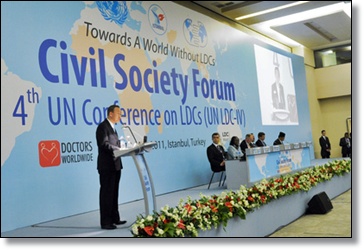Least Developed Countries: Reservoirs of Untapped Potential

 |
| Ban Ki-moon addresses UN-LDC forum UN Photo/E.Schneider |
They suffer disproportionately from largely preventable diseases. They are most vulnerable to natural disasters, environmental change and economic shocks. They are the least secure. Eight of the United Nations 15 peacekeeping operations are in least developed countries. In the past decade those nations have produced some 60 per cent of the world’s refugees.
The facts are plain. We live in an unbalanced world, an unfair world. With 12 per cent of the global population, LDCs account for just 1 per cent of world exports, and less than 2 per cent of global direct investment. Recent years have seen a transformation of the global economic landscape.
Since the 2001 Brussels Programme of Action was adopted, many LDCs have benefited from this changing environment. But others have seen little progress or have even slid back. We risk a splintered world economy, a widening gap between haves and have-nots, between those who have hope and those who do not.
This cannot continue.
I have painted rather a bleak picture. But there is another one, a landscape of opportunity. It is this outlook that I want to present to you today. It is time to change our mindset. Instead of seeing LDCs as poor and weak, let us recognize these 48 countries as vast reservoirs of untapped potential. Investing in LDCs is an opportunity for all.
First it is an opportunity to relieve the world’s most vulnerable people of the burdens of poverty, hunger and needless disease. This is a moral obligation. Second, investing in LDCs can provide the stimulus that will help to propel and sustain global economic recovery and stability. This is not charity, it is smart investment. Third, it provides a massive opportunity for South-South cooperation and investment. The world’s rapidly emerging economies need both resources and markets. LDCs can provide both — and are increasingly doing so. Fourth, the LDCs represent a vast and barely touched area for enterprise, for business.We have all the ingredients for success, for a genuine partnership for development.
I would like highlight some broad areas where we can reap the maximum benefits for LDCs and the global economy.
First, productive capacity. Most LDCs are rich in resources. All have young and vibrant populations. These men and women need decent jobs, education, training, so they can make the most of their country’s assets — minerals and other commodities, farmland, rich stores of biodiversity and tourism potential.
However, enhanced productive capacity will only be achieved with a dynamic and thriving private sector. One of the most significant aspects of this Conference is the enthusiastic engagement of the business community. Let us ensure that business has the right environment to thrive. It is no coincidence that the three countries that have graduated from the LDCs also score high on governance and democratic principles.
Let me now turn to the issue of aid. Official development assistance (ODA) to LDCs has nearly tripled in the past decade. But it remains below agreed targets. Yes, it is true that we live in times of austerity. But as I have said, assistance to LDCs is not charity, it is sound investment. Many also argue that current aid places too little emphasis on economic infrastructure and productive sectors. Furthermore, many LDCs are still saddled with unsustainable debt burdens. I urge lenders to revisit this issue.
Let me now turn to agriculture, which employs as much as 70 per cent of workers in LDCs. This is perhaps the most important sector for development. We need to invest more in smallholder farmers and the infrastructure they need. This means transferring appropriate technologies, supporting climate change adaptation and protecting ecosystems. We need to invest, too, in basic social protection and safety nets.
Global food prices are at new record levels. LDCs face a real prospect of a new crisis in food and nutrition security. In many LDCs, the poor spend more than half their incomes on food. More than 40 per cent of children in LDCs have had their growth and development stunted by malnutrition. A country that cannot feed its children cannot thrive.
My final point concerns trade. The international community has failed to follow through on global commitments in the Monterrey Consensus and the Doha Declaration on Financing for Development. I call again for a successful conclusion to the Doha Development Round of multilateral trade negotiations. There is little point in helping LDCs to grow food and other commodities, manufacture products and develop services if they cannot trade fairly in the global marketplace.
The United Nations system will continue to prioritize LDC issues throughout its programmes. We will work diligently with all partners to help implement the new Istanbul Programme of Action.
A measure of any society is how well it looks after its least fortunate. The same is true of the international community. Now is not the time to turn our backs, but to increase our support.
The past two decades saw spectacular progress among emerging economies. The LDCs are poised to be the next wave of development achievement. Let me emphasize again, ladies and gentlemen: I am not arguing for charity, but investment. The returns can be profound — not just for the people living in LDCs, but for all people — for the global economy. Success for the LDCs is ultimately success for all.
Let us try our best to make this world harmonious, balanced and better for all.
By Ban Ki-moon
UN Secretary-General.
